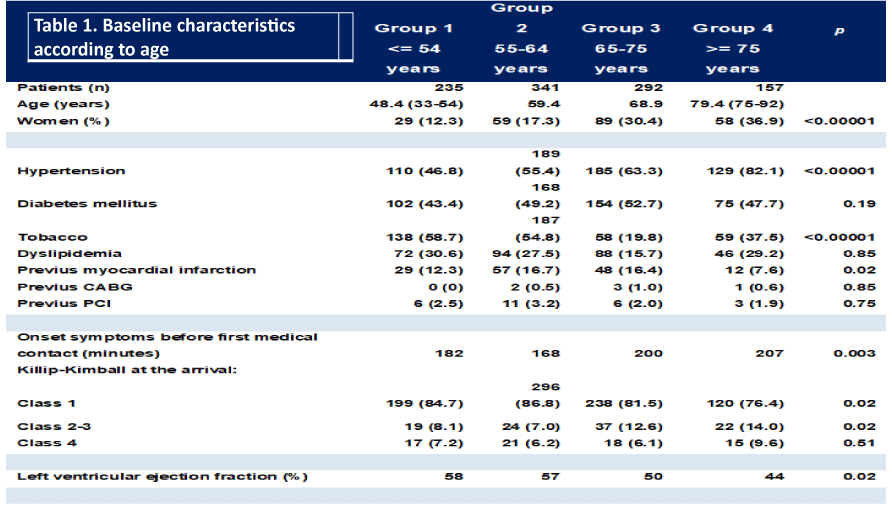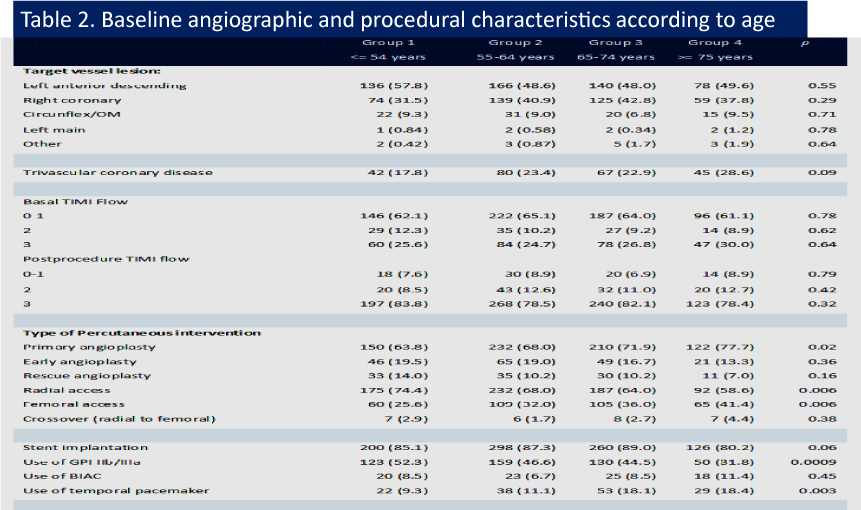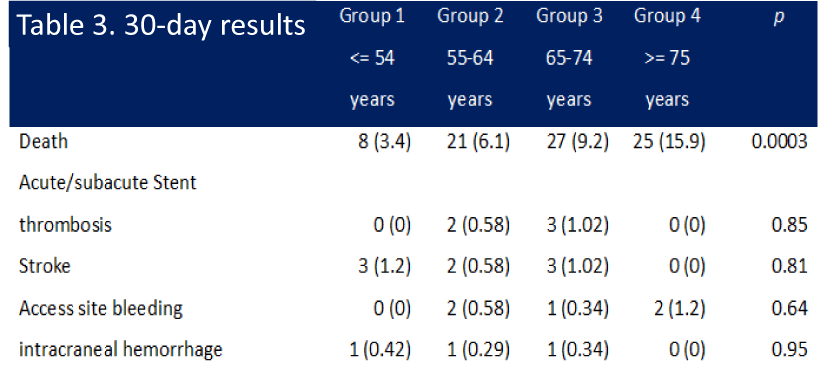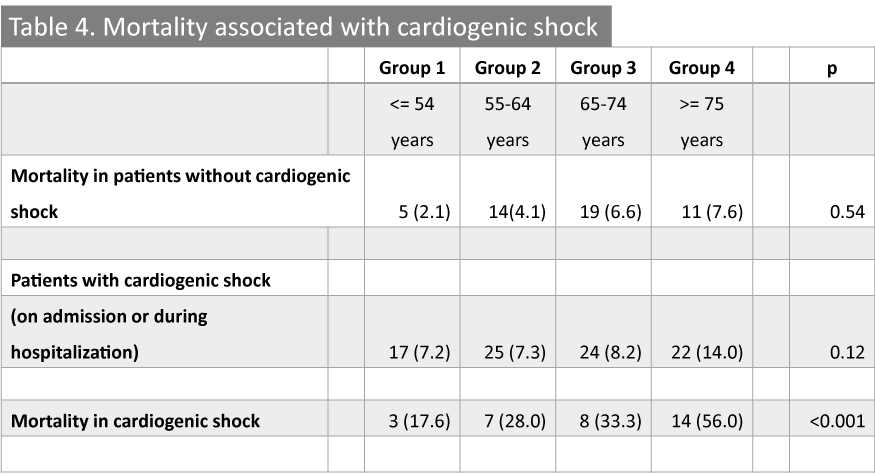Journal of Cardiovascular Medicine and Cardiology
Reperfusion of Acute Myocardial Infarction in the elderly (clinical characteristics and prognosis) Results of the IMSS Nuevo León infarction code program
Zapata Ruiz Alejandro1, Palacios R Juan Manuel2*, De la Cruz O Ramón3, Arboine A Luis1, Sierra F Ángel1 and Muñoz Consuegra Carlos1
2Fellow 2nd year Coronary Intervention, Mexico
3Interventional Cardiologist Assigned to the Department, Mexico
Cite this as
Alejandro ZR, Juan Manuel PR, O Ramón DlC, Luis AA, Ángel SF, et al. (2018) Reperfusion of acute myocardial infarction in the elderly (Clinical characteristics and prognosis) Results of the imss nuevo león infarction code program. J Cardiovasc Med Cardiol 5(3): 024-026. DOI: 10.17352/2455-2976.000066Background: The age is an important prognostic factor in patients with acute myocardial infarction. To find no similar data in the Mexican population, it seeks to establish the characteristics and prognosis of older adults carried out mechanical reperfusion treatment.
Methods and results: We carried out a retrospective analysis included a total of 1025 patients in the program code myocardial reperfusion treatment carried out, being the 15.3 % over the age of 75 years. The age range of 33 to 92 years. The mortality rate is increasing exponentially higher age (3.4 % for patients <= 54 years, 6.1% for 55 to 64 years, 9.2% for 65 to 75 years and 15.9 % for the >= 75 years, p<0,001) in patients older than 75 years, primary angioplasty is the preferred method of reperfusion (77.7 %), without finding in this group of patients, an increase in the cerebral vascular event ischemic or hemorrhagic. Over the age of 75 years who develop cardiogenic shock have a much higher mortality compared with the younger (17.6%, 28%, 33% vs 56%, p<0.001).
Conclusions: Despite the different treatments of reperfusion, mortality remains higher in older adults, mainly by multiple comorbidities and a higher rate of ventricular dysfunction.
Introduction
Cardiovascular disease is the main cause of morbidity and mortality among older adults, which is why this group is currently considered of vital importance in the study of ischemic heart disease [1]. We know that age is a major cardiovascular risk factor and coronary artery disease (CAD) is the main cause of death in old age [2]. In the United States, there is an annual increase of 160,000 octagenarians, estimating that by 2040, there will be an increase of 5 times the current population is said group of people [3]. Although there is no established age cut-off for this group, people aged 75 and older are usually referred to as “older adults”, based on the fact that the treatment guidelines emphasize this group of patients, issuing some changes from this age [3]. Although it is true that these international treatment recommendations make no difference in diagnosis and treatment according to age, in real life, older adults historically have lower rates of revascularization compared with younger patients [4], as well as in the main clinical studies. Controlled, this group of patients is underestimated or even excluded. However, in recent years there has been an attempt to offer percutaneous coronary intervention (PCI) to this group of patients, so that, in practice, one in five patients treated by PCI, belongs to this group [5]. In our country, we do not have studies that evaluate the behavior and prognosis of this population in the context of an acute myocardial infarction with ST-segment elevation, so from this record it is intended to analyze the characteristics of this age group, similarities and differences with the younger population and the results obtained with the reperfusion treatment.
Methods
Cohort and study protocol
The “Infarction Code” program of the Mexican Institute of Social Security, consists of providing mechanical reperfusion treatment to patients with acute myocardial infarction with ST-segment elevation (AMI), who come to the Emergency Department of our Hospital or are treated in Hospitals without primary angioplasty capacity. This study is a retrospective analysis of a single third level Hospital Center, which includes all patients with AMI taken to mechanical reperfusion treatment in any of its modalities (primary, early or rescue angioplasty). The data were obtained in detail from the file and electronic database belonging to the Department of Hemodynamics and Interventionism. Acute myocardial infarction with ST segment elevation was defined as an episode of angina of more than 20 minutes duration in conjunction with any of the following: (1) ST segment elevation of more than 0.2 mV in two contiguous leads (v1) to v3) and more than 0.1 mV in any other derivation, or (2) the presence of Left bundle blocking of the His bundle. The success of the procedure was defined as a post-procedure TIMI 2 or 3 flow. The ejection fraction of the left ventricle was obtained from the transthoracic echocardiogram performed upon admission to the Coronary Care Unit. The events that were compared between the four groups included non-fatal reinfarction, acute and subacute stent thrombosis, ischemic cerebral vascular event, major hemorrhage and intrahospital mortality and at 30 days. In summary, 1025 patients of any age with AMI within the first 12 hours at the onset of symptoms, between January 2016 and December 2017. All patients received Aspirin and Clopidogrel prior to the procedure. The frequency of events was assessed in both the in-hospital and extra-hospital phases through follow-up by external consultation.
Statistic analysis
The demographic, angiographic and procedural variables, and clinical results based on age were determined by the analysis of four groups (<54 years, 55-64, 65-74 and >75 years). Fisher’s exact test was used. For the comparison of the categorical variables and the test of x2 for the comparison between the four groups. Logistic and multivariate regression analyzes were performed to identify independent predictors
Results
Baseline characteristics
The average age of the 1025 patients is 62 years, in a range of 33 to 92 years. Patients <= 54, 55-64, 65-74 and >= 75 years form 22.9%, 33.2%, 28.5% and 15.4% of the study cohort. As seen in table 1, older adults have a higher proportion of women, and a higher probability of having high blood pressure, and previous cerebral vascular event. Cardiovascular risk factors such as diabetes mellitus, dyslipidemia or tobacco use are not more frequent in the group of older adults, being even more prevalent at younger ages. Within the background of importance, in our cohort, the history of infarction and revascularization treatment was found in a lower proportion in the older group.
Characteristics of the procedure
As shown in table 2, the older adults compared with the younger ones, the CAD is more extensive, and arteries of smaller diameter. Basal and postprocedural TIMI flow is independent of age. The type of procedure also varies in different age groups, with a preference for primary angioplasty in those of older age. The radial approach is used less frequently in the elderly, as well as the administration of glycoprotein IIb / IIIa inhibitors (Abciximab or Tirofiban).
Mortality and events greater than 30 days
As shown in table 3, compared with younger patients, older adults have the highest mortality. In the multivariate analysis, advanced age is a strong independent predictor of death (hazard ratio 1.08, 95% CI 1.03 to 1.1, p <0.001) and major bleeding (hazard ratio 1.05, 95% CI 1.03 to 1.09 p <0.02). In contrast, the rate of ischemic stroke, intracerebral hemorrhage, and stent thrombosis were not directly related to age.
Discussion
The main findings of this registry represent the largest cohort of the Mexican population with these characteristics. There is no registry in our population that examines the results of mechanical reperfusion therapy in the elderly and its follow-up. First, older adults with acute myocardial infarction who are taken to PCI present with a greater number of comorbidities, which confer a worse prognosis in the short and long term. It is striking that, in the population studied, the history of coronary artery disease and revascularization by any method is not more prevalent in older adults, which is not in relation to that published in international series, rather, it reflects the lack of medical attention in this group of patients, and with it the importance of programs for the care of acute myocardial infarction. One of the main factors in the success of reperfusion treatment is to establish the time from the onset of symptoms to carry out the reperfusion treatment, and between the onset of symptoms at the first medical contact, finding a relationship that, at older age, the diagnosis and treatment is delayed. This correlates with the severity of admission, assessed by the Killip-Kimball scale, with a greater number of patients with grade II and III. Although the presence of cardiogenic shock on admission was not more prevalent in the elderly, its presence does influence the prognosis, as we will see later. Compared with younger patients, in older adults coronary artery disease is more extensive, which has a direct relationship with more depressed ventricular function and the development of cardiogenic shock. Although in different series, the rate of ischemic or hemorrhagic cerebral vascular event is observed more frequently in the elderly [6], in our series this phenomenon was not observed, which may be the explanation, that primary angioplasty is preferred, minimizing the risk of thrombolysis (the intracranial hemorrhage events of the cohort occurred in thrombolyzed patients) [7] as well as a decrease in the use of glycoprotein IIb / IIIa inhibitors, which have not shown a strong benefit in the elderly. While the radial approach was used less frequently in older adults, the rate of bleeding related to access was not more frequent in this group and the need for conversion to the femoral approach is not greater compared with younger patients [5,8]. It is important to emphasize that the success of the procedure is not affected by age, although we know that coronary anatomy is much more complex, mechanical reperfusion can be carried out in older adults with success rates similar to younger ones [9]. With this, we realize that the factors of greater weight in the mortality of this group are the comorbidities of age, and mainly the development of left ventricular dysfunction [10]. When we see mortality in patients who do not develop a shock state, this is similar for any age group, however, in the subgroup patients with cardiogenic shock, age is an independent factor of death, which implies that, older age the possibility of reversing this state of shock is much lower, this is largely conditioned by the extension of Coronary disease, previous ventricular dysfunction and multiple associated comorbidities (Table 4).
Study limitations
This study has the limitations of the registers, where the comparison between the groups is not randomized. In addition, it is a record of a single hospital center, so these results are the accumulation of experience and management of this Center, and can not be extrapolated to all hospitals in the country.
Conclusion
The elderly of the Infarction Code program in our entity represent 15.3% of the procedures performed, with a tendency to increase their frequency in the short term. The clinical characteristics of older adults include higher comorbidity, more complex coronary anatomy, and acute myocardial infarction with more critical clinical presentation. Primary angioplasty is the method of choice in this group of patients, which significantly reduces the risk of major bleeding. Although postprocedure results are comparable among all age groups, mortality is higher as age is more advanced, results that are comparable to the series published in the literature.
- Shanmugam VB, Harper R (2015) An overview of PCI in the very elderly. J Geriatr Cardiol. 12: 174−184. Link: https://goo.gl/cJUkNT
- Wang TY, Gutiérrez A, Peterson DE (2011) Percutaneous coronary intervention in the elderly Nat. Rev. Cardiol. 8:79–90. Link: https://goo.gl/SEHBkB
- Ibanez B, James S, Agewall S (2017) ESC Guidelines for the management of acute myocardial infarction in patients presenting with ST-segment elevation. European Heart Journal.1–66. Link: https://goo.gl/rPW6PT
- Levine GN, Bates ER (2011) ACCF/AHA/SCAI Guideline for Percutaneous Coronary Intervention J Am Coll Cardiol. 58:44–122. Link: https://goo.gl/bhooEM
- Campo C, Ferreira RP, Teixeira C (2013) Percutaneous Coronary Intervention using Transradial Access in Elderly vs. Non-Elderly Patients Rev Bras Cardiol Invasiva. 21:36-42. Link: https://goo.gl/WVS5WY
- Thiemann DR, Coresh F, Shulman P (2000) Lack of Benefit for Intravenous Thrombolysis in Patients with Myocardial Infarction Who Are Older Than 75 Years. Circulation. 101:2239-2246. Link: https://goo.gl/1ghfmb
- Capodanno D, Angiolillo DJ (2010) Antithrombotic Therapy in the Elderly. J Am Coll Cardiol. 56: 1683–92. Link: https://goo.gl/UKf99y
- Hsieh V, Jolly SS (2012) Should Radial Access Be the Preferred Approach in the Elderly? Rev Bras Cardiol Invasiva; 20. Link: https://goo.gl/APTMY2
- Sim WL, Mutha V (2017) Clinical characteristics and outcomes of octogenarians presenting with ST elevation myocardial infarction in the Australian population. World J Cardiol. 9: 437-441. Link: https://goo.gl/nRttFz
- Guagliumi G, Stone GW, Cox DA (2004) Outcome in Elderly Patients Undergoing Primary Coronary Intervention for Acute Myocardial Infarction, Results From the Controlled Abciximab and Device Investigation to Lower Late Angioplasty Complications (CADILLAC) Trial Circulation.110:1598-1604. Link: https://goo.gl/sVs5Fc

Article Alerts
Subscribe to our articles alerts and stay tuned.
 This work is licensed under a Creative Commons Attribution 4.0 International License.
This work is licensed under a Creative Commons Attribution 4.0 International License.




 Save to Mendeley
Save to Mendeley
